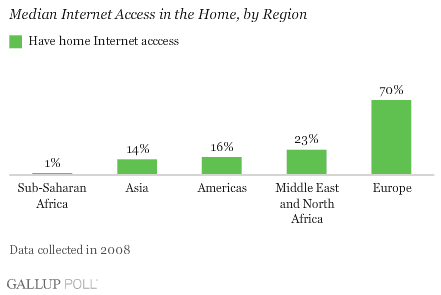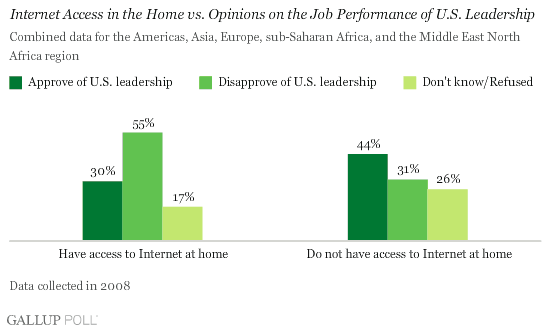WASHINGTON, D.C. -- On March 10, Congress passed the 2009 Omnibus Appropriations bill, which, among other provisions, determines how much the U.S. government will spend on diplomacy, international security, and projecting the U.S. image abroad. Gallup surveys of more than 100 countries in 2008 suggest a link between the likelihood to be connected to communications infrastructure (TV, telephone, and Internet in the home) and the likelihood that respondents disapproved of U.S. leadership.

An examination of the relationship between the Gallup Communications Index, which measures the extent to which respondents are connected via electronic communications, and U.S. leadership ratings shows a relationship at the quartile level in some regions with disapproval of U.S. leadership.
In sub-Saharan Africa, communications infrastructure is generally less developed, and approval of U.S. leadership tends to be high. When data from this region are removed from the comparison, the relationship between communications and U.S. approval no longer declines across quartiles. Approval remains relatively steady regardless of communications quartile. However, disapproval percentages tend to increase across quartiles.

At the regional level, Gallup finds that in the Americas, Europe, and in the Middle East and North Africa region, there is a general upward trend in the likelihood of disapproval between the bottom and top communications quartiles. In Asia and sub-Saharan Africa, approval and disapproval percentages generally trend upward between the bottom and top quartiles.
This does not mean developed communication infrastructures are the source of negative opinions about U.S. leadership or cause them. Instead, Gallup's data suggest that, in some regions, the more likely respondents were to report they had household access to telecommunication technologies such as the Internet, telephone, and television, the more likely they were to disapprove of American leadership. Gallup also compared other factors, such as income, education, and age, to American approval ratings, but the relationship was not as clear as with communications.
These findings are relevant in light of the prospect that if enacted by the White House, the proposed budget would mean a sizeable increase over the 2008 budget. This includes an increase in public diplomacy exchanges and broadcasting, which could increase the visibility of U.S. diplomatic messaging in many parts of the world for those with access to communications media.
Background on American Public Diplomacy
Public diplomacy is one component of how the United States projects its image abroad, seeking to indirectly influence behavior and attitudes in other countries through cultural and ideological exchange.
James K. Glassman, the former Undersecretary of State for Public Diplomacy and Public Affairs, sought to improve international attitudes toward the United States by presenting an accurate picture of U.S. policies and the motivations behind them. Glassman was a strong proponent of "Public Diplomacy 2.0," which means more focus on new media technologies, such as Web-based social networking technologies, to engage young foreign audiences in U.S. and global issues.
However, Gallup data show that home Internet availability varies around the world. Gallup collected data on home Internet access in more than 100 countries in 2008 and found that the median percentage of respondents who say they have Internet connections at home is 14%. Regionally, the median percentages range from 1% who say they have home Internet in sub-Saharan Africa, to 70% who say they have it in Europe.

Further, Gallup finds that in some regions there is a link between respondents who have home Internet access and their likelihood of disapproving of U.S. leadership. Home Internet access is one factor used to calculate Gallup Communications Index scores.

The relationship is not evident in every world region. In the Americas and Europe, home Internet access does not significantly affect the likelihood of approval, but those with Internet are more likely to disapprove. In Asia, respondents with home Internet access are more likely to have an opinion than those who do not have Internet access in their home, and higher percentages approve and disapprove. Data from sub-Saharan Africa show no clear relationship.
And in the Middle East and North Africa region, those with home Internet access are actually more likely to approve of U.S. leadership and less likely to disapprove. Here the relationship is heavily influenced by respondents in Israel and Djibouti, where relatively large numbers of respondents with home Internet approve of U.S. leadership.
Again, this does not mean Internet access is the root of negative opinions about U.S. leadership. The Internet offers users access to diverse information sources. Those sources can potentially influence a person's opinion of U.S. leadership positively or negatively, although we cannot draw such inferences from Gallup's data. Mitchell Polman, blog contributor with the USC Center on Public Diplomacy, argues that, considering the low Internet penetration worldwide, the U.S. government should not forget the importance and reach of "Public Diplomacy 1.o," or focusing on radio and the printed word.
Future Funding for Public Diplomacy
The recently approved Omnibus Appropriations bill proposes a sizeable increase over last year's budget. Sen. Robert C. Bryd, Chairman of the Senate Appropriations Committee, hopes this legislation will help "turn the page to the next chapter in American foreign policy." Considering the relationship between access to information sources and disapproval of U.S. leadership in many countries, tomorrow's public diplomacy will likely seek to project America's positive values, using the most appropriate communications media, to the largest possible audiences.
Survey Methods
Results are based on telephone and face-to-face interviews with approximately 499 to 4,349 adults, aged 15 and older, conducted in 2008 in each country. For results based on the total sample of national adults, one can say with 95% confidence that the maximum margin of sampling error ranges from ±3 to ±6 percentage points. The margin of error reflects the influence of data weighting. In addition to sampling error, question wording and practical difficulties in conducting surveys can introduce error or bias into the findings of public opinion polls.
